We slept in a bit and ate a breakfast, whipped up by Mike, of scrambled eggs with spinach and cheese, apricot juice, a sliced nectarine and espresso. Before leaving for San Gimignano, we walked around the ancient manor of Fulignano, in which our apartment was housed, leaving our Airbnb by 9:40.
It was supposed to be cloudy all day and around 65°F. We hoped it wouldn’t rain. We drove along a dirt road lined with cypress trees, rolling hills, vineyards, and beautiful Tuscan homes. We could see in the distance the hilltop town of San Gimignano, with its many towers.

on the way to San Gimignano

San Gimignano from afar
San Gimignano, 54km SW of Florence, is a hilltop town with 14 medieval skyscrapers. At the height of the Guelph-Ghibelline conflict (from the 12th to the 15th centuries), there were over 70 towers built partly for defensive purposes. They offered safe refuge and were used to pour boiling water over attacking enemies. The towers also bolstered the egos and flaunted the wealth of the owners, who competed to build the highest tower.
The plague of 1348 and the subsequent population decline dealt a severe blow to the trading economy of San Gimignano. The crisis led the governors to submit to Florence in 1353, but this didn’t help as the city suffered further decline and neglect. In recent years, the beauty of the town and its architectural and artistic importance have led to economic and cultural revival.
Upon parking in the town around 10:00, we went into the late-13th-century Chiesa de Sant’Agostino (Church of St. Augustine), the second largest church in town after the Collegiata. It is owned by the Order of Saint Augustine. Inside, Benozzo Gozzoli’s 15th-century fresco cycle (1464-65) depicted scenes from the life of St. Augustine, whose work was valuable in developing early Church doctrine. Augustine, like many saints, sinned often before finding God, but instead of suffering through deprivations and martyrdom, he focused on the reconciliation of faith and thought.

entering San Gimignano

a courtyard in San Gimignano

chiesa de Sant’Agostino

chiesa de Sant’Agostino

chiesa de Sant’Agostino
We walked past the Duomo di San Gimignano and the Palazzo Comunale.

Duomo di San Gimignano
The 13th-century Palazzo Comunale has always been the center of the town’s local government.

Palazzo Comunale

towers of San Gimignano
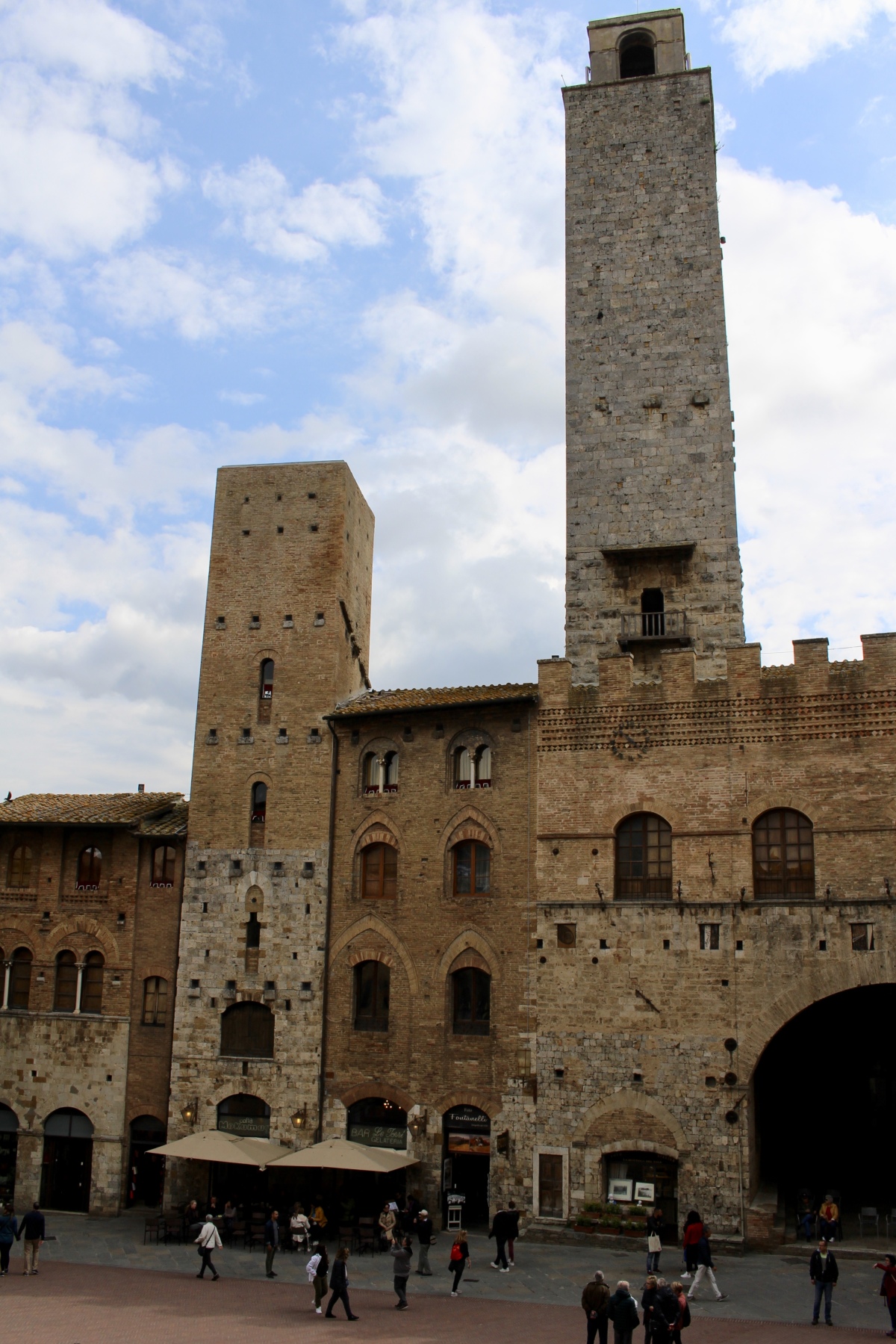
towers of San Gimignano
We went into the Musei Civici, where we climbed the 54-meter tall Torre Grossa, or Great Tower, for views of the town. The tower was built in 1311.

view of San Gimignano from Torre Grossa
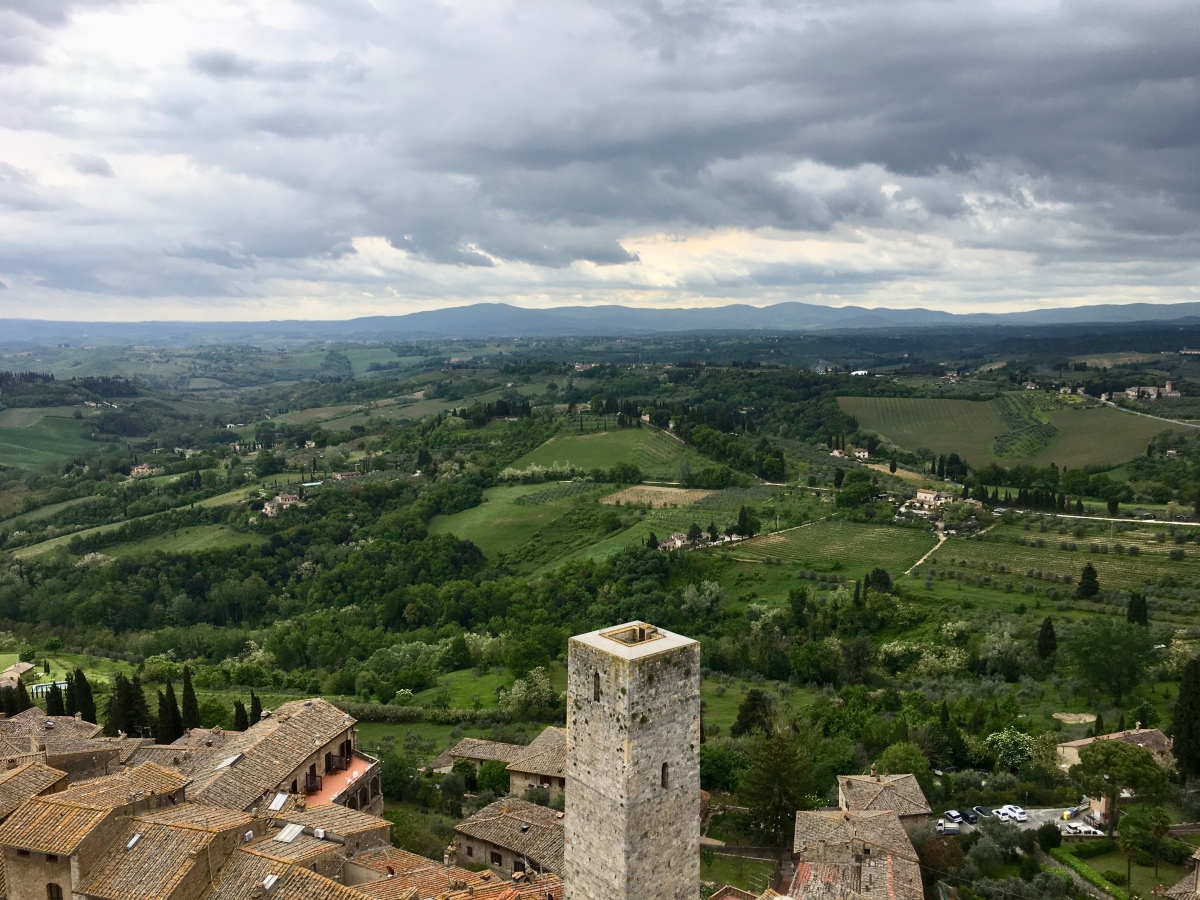
view of San Gimignano from Torre Grossa

view of San Gimignano from Torre Grossa

view of San Gimignano from Torre Grossa

view of San Gimignano from Torre Grossa
Then we wandered though the second floor of the Musei Civici, where we found paintings by famous Renaissance painters, Pinturicchio and Benozzo Gozzoli. In a small room off the stairway, we encountered risqué frescoes by Memmo di Filippuccio (1288-1324) depicting courtship, a shared bath, and the wedding of a young androgynous-looking couple, but I somehow missed taking photos of those. The main council chamber held a 14th-century Maestà by Lippo Memmi.
We went into the Romanesque Duomo di San Gimignano, also called the Collegiata di San Gimignano, full of fine colorful frescoes covering nearly every part of the interior. It was consecrated in 1148. Bartolo di Fredi’s 14th-century fresco cycle of Old Testament scenes is on one wall; the opposite wall shows the Life of Christ by 14th-century artist Lippo Memmi.

Duomo di San Gimignano
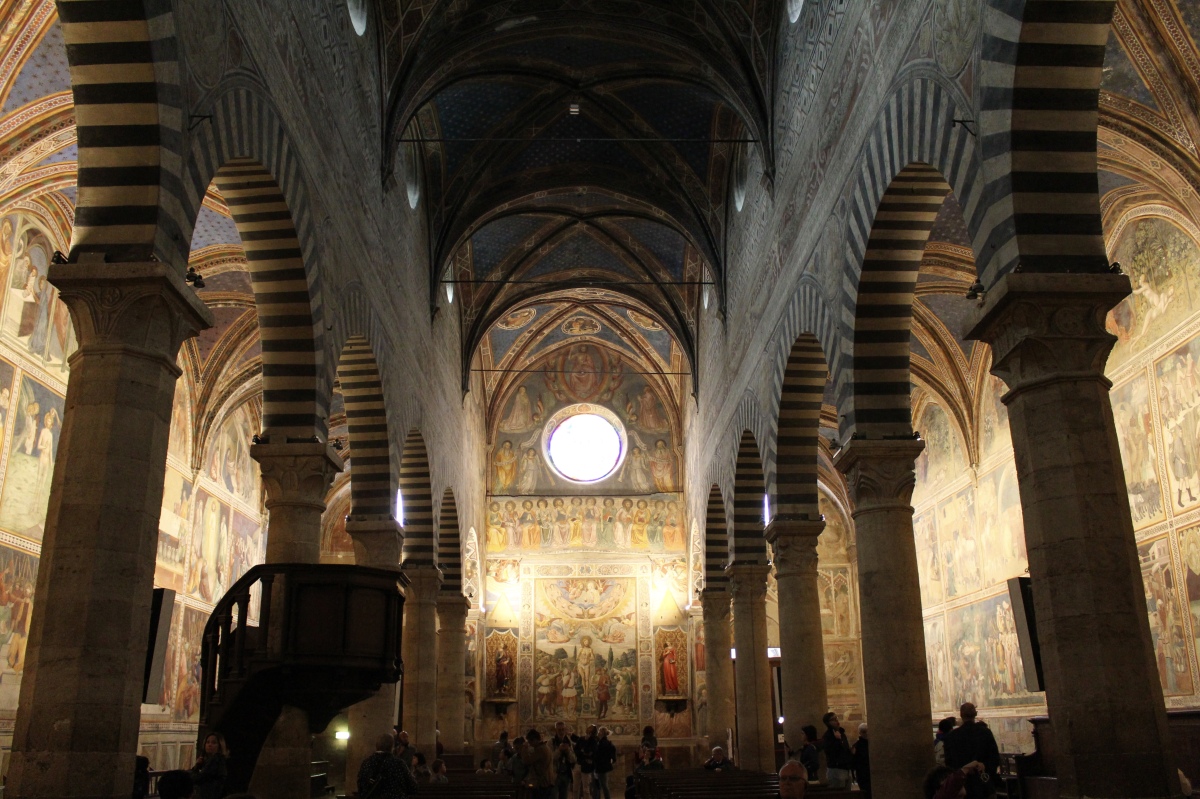
Duomo di San Gimignano

Duomo di San Gimignano
The Renaissance Capella di Santa Fina, and fresco cycle by Dominico Ghirlandaio, illustrates the life of St. Fina. The small girl had a terminal disease and repented of her sins, one of which included accepting an orange from a boy, by lying on a wooden board tormented by rats. At the moment of her death, yellow violas blossomed from the board.

Capella di Santa Fina
After visiting the church, it started raining, so we sought refuge in a cafe, where we enjoyed coffee, salty pastries, and a blueberry pastry with powdered sugar. When the rain let up slightly, we ventured out, bought umbrellas at a small shop, and wandered around under cover.
We walked through the Plaza della Cisterna.

Plaza della Cisterna

Plaza della Cisterna

San Gimignano
In our rambles, we stumbled upon the highest point in town, the medieval Rocca di Montestaffoli San Gimignano, a fortress dating from 1353, with a wonderful view over the town and the countryside.
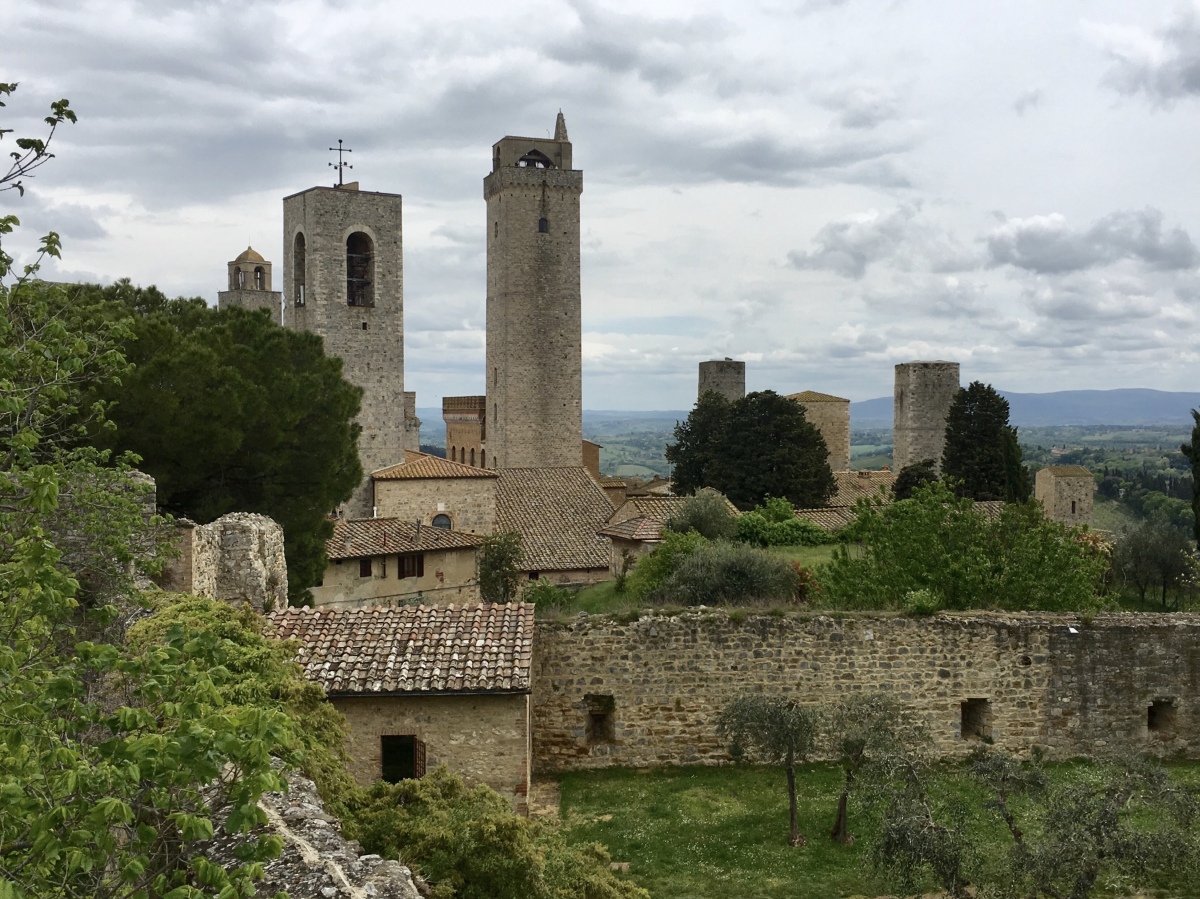
Rocca di Montestaffoli San Gimignano
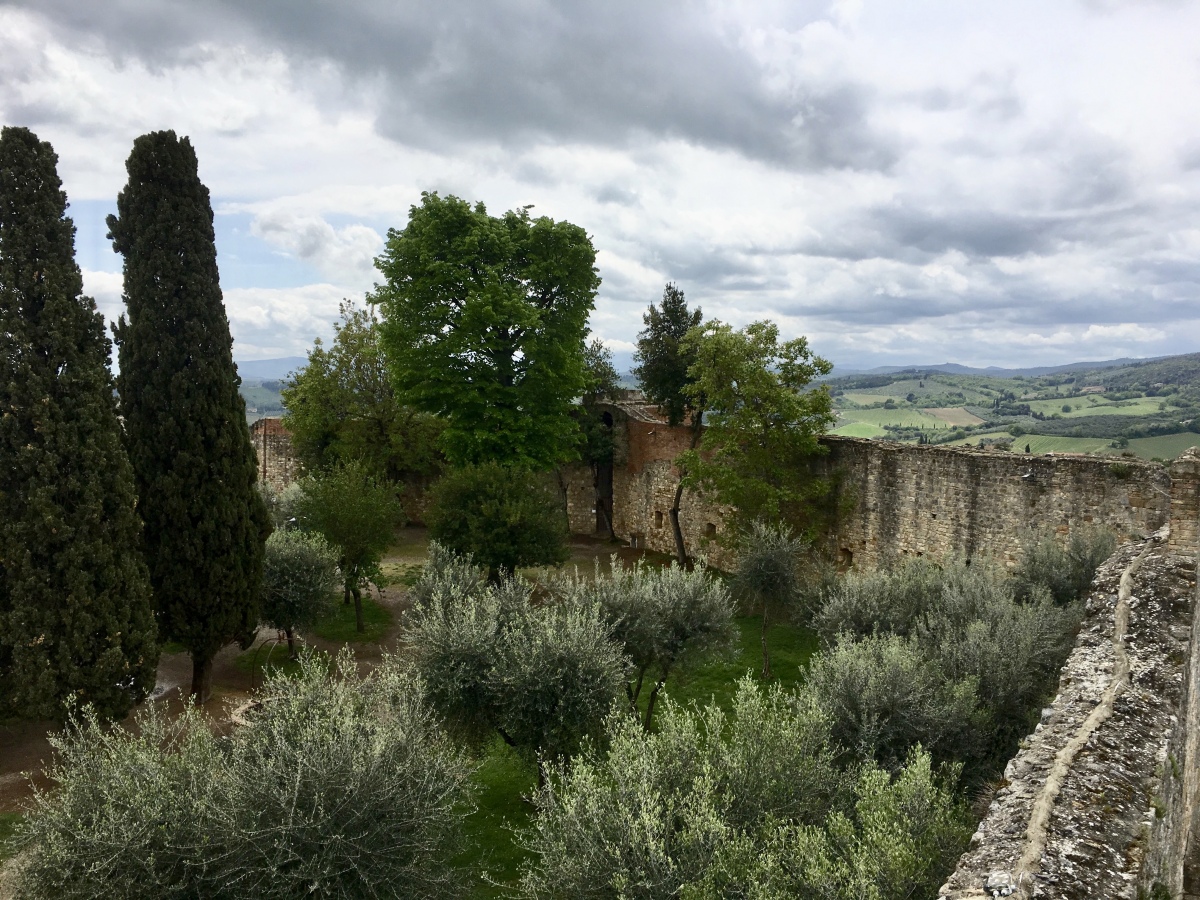
Rocca di Montestaffoli San Gimignano

Rocca di Montestaffoli San Gimignano

Rocca di Montestaffoli San Gimignano
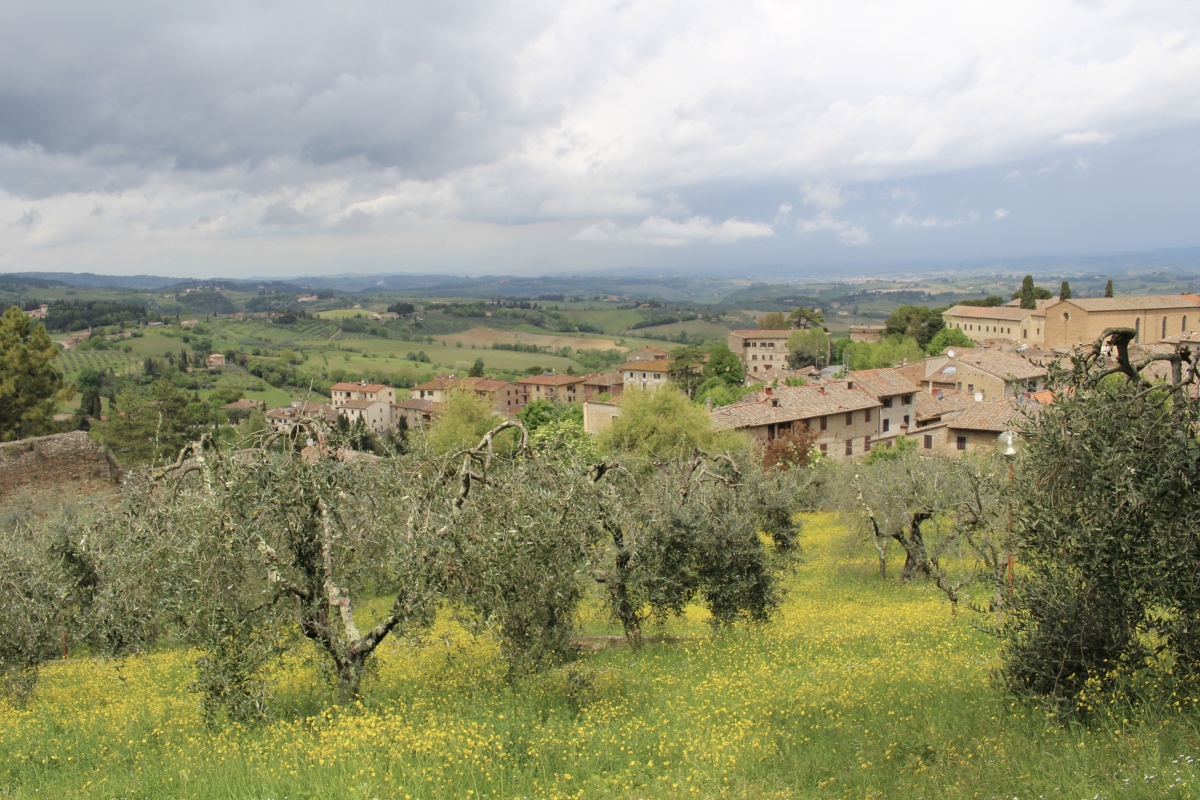
Rocca di Montestaffoli San Gimignano
Back in town, we dipped into a few shops. We bought two black and white photos of little Fiats in the Italian countryside and a leather journal. Mike bought a very stylish black Italian jacket and two nice Italian shirts.

towers of San Gimignano
We left San Gimignano to drive to Volterra around 2:00.
*Friday, May 3, 2019*











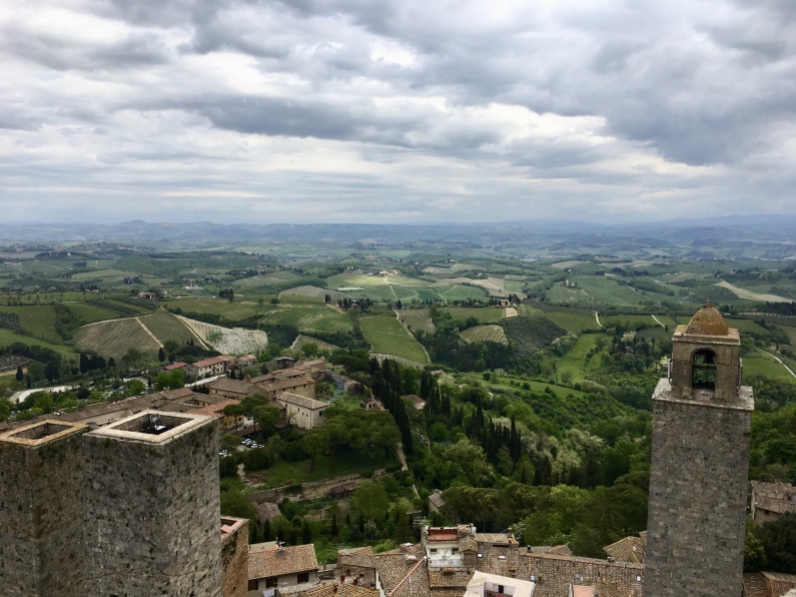







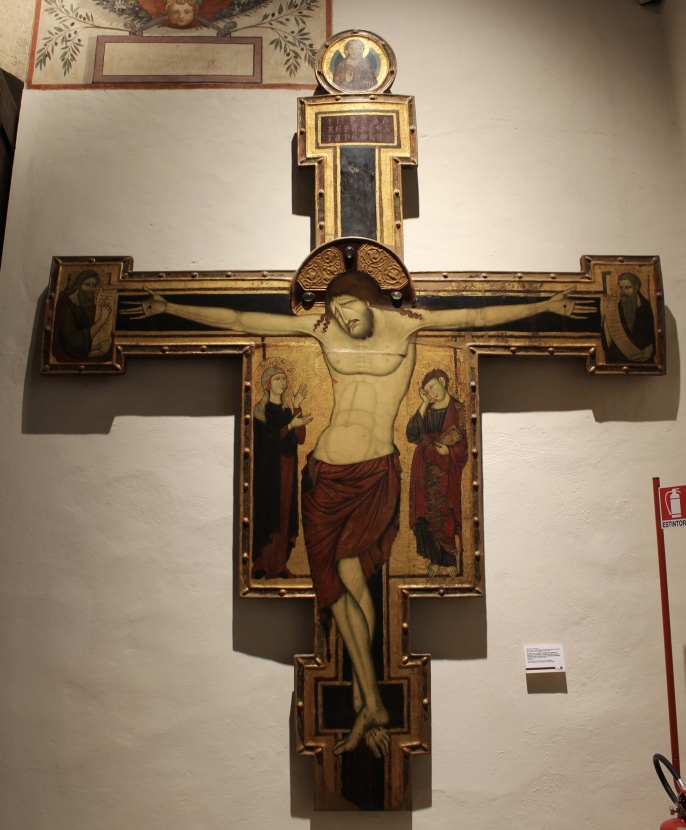































Wow, San Gimignano and its soarings towers, looks like an amazing place to explore. I would love to go back to Italy once is safe to do so, but for now, like the majority of the world, we are looking forward to seeing more of our home country. Thanks for sharing and inspiring 😀 Aiva
LikeLike
It was a fun place to explore for sure, Aiva. It seems we too will be staying in the U.S. this year, as no one in Europe will have us, and I’m afraid to go to any third world country with the virus still running rampant. I hope we can keep holding out hope for some travel days in the near future. Thanks to you for visiting and commenting. 🙂
LikeLiked by 1 person
It looks to me like a place that’s very much better to look down on than to be at ground level, Cathy. Those towers make me feel penned in but up on the rooftops it’s beautiful, despite the grey skies. 🙂 🙂 As always, the wonderful artworks! Have a good Sunday 🙂
LikeLike
San Gimignano was a great place to see from its many towers, Jo. It was quite a cute town, but seemed gloomy because of the weather. Thanks. I hope you’re having a good week. 🙂
LikeLiked by 1 person
Oh those Tuscan villages! 🙂
LikeLike
Yes, Pit. They’re so charming! 🙂
LikeLike
I love San Gimignano, it’s just gorgeous. I was happy to explore the churches with you because I make a point when it Italy or Spain to only visit the odd church, and then only if they have a special painting or sculpture I want to see. I find it all a bit too much, but I enjoy reading about them. My happy times are to wander the streets and absorb the atmosphere, or sit outside cafes with a drink and watch the world go by, especially the passagieta (my spelling may be suspect there).
LikeLike
The churches everywhere in Europe can be overwhelming, Mari. After a while, I get burned out from them. I also prefer just wandering the streets and stopping into cafes. If I could do that all day, I’d be perfectly happy, I think. If only I lived in Europe, I could take more time to while away the days. 🙂
LikeLike
Aaaah, brings back memories!
LikeLike
I’m glad, Sue! 🙂
LikeLiked by 1 person
😊😊
LikeLiked by 1 person
With such beautiful surroundings it must have been tempting to just spend the day relaxing at your Airbnb. But I’m glad you didn’t because the places you went are lovely and very interesting.
LikeLike
It was tempting to stay at our Airbnb, Carol, and we might have done so if the weather had been conducive to sitting by the pool. But it was cold, windy and cloudy, so not pool weather at all. 🙂
LikeLike
This seems to have been a very pleasant for you two. I’m glad. Your pace seems unhurried. The town itself is intriguing with its height and all. You mention a point in time that is the height (itself) of a three-hundred-year war. I know such war happened in other places, too. Imagine generations knowing nothing but a culture of (at) war.
LikeLike
We had very relaxing days in Tuscany, Christopher. We just hopped from hill town to hill down, drank wine, and ate delicious Italian food. It’s good I went last year, because I couldn’t eat all that pasta, cheese and pizza now. 😦 I can’t imagine living under long term wars. But many people have done so and still do, don’t they? It’s such a tragedy.
LikeLike
It looks every bit as beautiful as I expected (despite the rain).
LikeLike
I hope when you ever make it there, you have sunny skies!
LikeLiked by 1 person